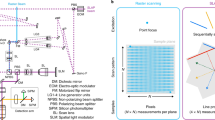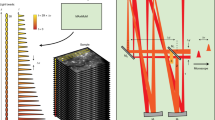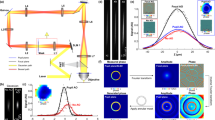Abstract
Elucidating the volumetric architecture of organelles and molecules inside cells requires microscopy methods with a sufficiently high spatial resolution in all three dimensions. Current methods are limited by insufficient resolving power along the optical axis, long recording times and photobleaching when applied to live cell imaging. Here, we present a 3D, parallelized, reversible, saturable/switchable optical fluorescence transition (3D pRESOLFT) microscope capable of delivering sub-80-nm 3D resolution in whole living cells. We achieved rapid (1–2 Hz) acquisition of large fields of view (~40 × 40 µm2) by highly parallelized image acquisition with an interference pattern that creates an array of 3D-confined and equally spaced intensity minima. This allowed us to reversibly turn switchable fluorescent proteins to dark states, leading to a targeted 3D confinement of fluorescence. We visualized the 3D organization and dynamics of organelles in living cells and volumetric structural alterations of synapses during plasticity in cultured hippocampal neurons.
This is a preview of subscription content, access via your institution
Access options
Access Nature and 54 other Nature Portfolio journals
Get Nature+, our best-value online-access subscription
$29.99 / 30 days
cancel any time
Subscribe to this journal
Receive 12 print issues and online access
$209.00 per year
only $17.42 per issue
Buy this article
- Purchase on Springer Link
- Instant access to full article PDF
Prices may be subject to local taxes which are calculated during checkout






Similar content being viewed by others
Data availability
The data that support the findings of this study are available from the corresponding author upon reasonable request.
Code availability
The software used to acquire the super-resolved data (hardware control, image reconstruction and deconvolution pipeline) were developed by our laboratory and available upon request.
References
Schmidt, R. et al. Spherical nanosized focal spot unravels the interior of cells. Nat. Methods 5, 539–544 (2008).
Shtengel, G. et al. Interferometric fluorescent super-resolution microscopy resolves 3D cellular ultrastructure. Proc. Natl Acad. Sci. USA 106, 3125–3130 (2009).
Aquino, D. et al. Two-color nanoscopy of three-dimensional volumes by 4Pi detection of stochastically switched fluorophores. Nat. Methods 8, 353–359 (2011).
Huang, B., Wang, W., Bates, M. & Zhuang, X. Three-dimensional super-resolution imaging by stochastic optical reconstruction microscopy. Science 319, 810–813 (2008).
Juette, M. F. et al. Three-dimensional sub-100 nm resolution fluorescence microscopy of thick samples. Nat. Methods 5, 527–529 (2008).
Pavani, S. R. et al. Three-dimensional, single-molecule fluorescence imaging beyond the diffraction limit by using a double-helix point spread function. Proc. Natl Acad. Sci. USA 106, 2995–2999 (2009).
Willig, K. I., Harke, B., Medda, R. & Hell, S. W. STED microscopy with continuous wave beams. Nat. Methods 4, 915–918 (2007).
Huang, F. et al. Ultra-high resolution 3D imaging of whole cells. Cell 166, 1028–1040 (2016).
Gustafsson, M. G. L. et al. Three-dimensional resolution doubling in wide-field fluorescence microscopy by structured illumination. Biophys. J. 94, 4957–4970 (2008).
Shao, L., Kner, P., Rego, E. H. & Gustafsson, M. G. Super-resolution 3D microscopy of live whole cells using structured illumination. Nat. Methods 8, 1044–1046 (2011).
Hell, S. W. & Wichmann, J. Breaking the diffraction resolution limit by stimulated emission: stimulated-emission-depletion fluorescence microscopy. Opt. Lett. 19, 780–782 (1994).
Klar, T. A., Engel, E. & Hell, S. W. Breaking Abbe’s diffraction resolution limit in fluorescence microscopy with stimulated emission depletion beams of various shapes. Phys. Rev. E 64, 066613 (2001).
Hell, S. W., Jakobs, S. & Kastrup, L. Imaging and writing at the nanoscale with focused visible light through saturable optical transitions. Appl. Phys. A Mater. Sci. Process. 77, 859–860 (2003).
Hofmann, M., Eggeling, C., Jakobs, S. & Hell, S. W. Breaking the diffraction barrier in fluorescence microscopy at low light intensities by using reversibly photoswitchable proteins. Proc. Natl Acad. Sci. USA 102, 17565–17569 (2005).
Grotjohann, T. et al. Diffraction-unlimited all-optical imaging and writing with a photochromic GFP. Nature 478, 204–208 (2011).
Testa, I. et al. Nanoscopy of living brain slices with low light levels. Neuron 75, 992–1000 (2012).
Bohm, U., Hell, S. W. & Schmidt, R. 4Pi-RESOLFT nanoscopy. Nat. Commun. 7, 10504 (2016).
Grotjohann, T. et al. rsEGFP2 enables fast RESOLFT nanoscopy of living cells. eLife 1, e00248 (2012).
Pennacchietti, F. et al. Fast reversibly photoswitching red fluorescent proteins for live-cell RESOLFT nanoscopy. Nat. Methods 15, 601–604 (2018).
Chmyrov, A. et al. Nanoscopy with more than 100,000 ‘doughnuts’. Nat. Methods 10, 737–740 (2013).
Masullo, L. A. et al. Enhanced photon collection enables four dimensional fluorescence nanoscopy of living systems. Nat. Commun. 9, 3281 (2018).
Rego, E. H. et al. Nonlinear structured-illumination microscopy with a photoswitchable protein reveals cellular structures at 50-nm resolution. Proc. Natl Acad. Sci. USA 109, E135–E143 (2012).
Li, D. et al. Extended-resolution structured illumination imaging of endocytic and cytoskeletal dynamics. Science 349, aab3500 (2015).
Xue, Y. & So, P. T. C. Three-dimensional super-resolution high-throughput imaging by structured illumination STED microscopy. Opt. Express 26, 20920–20928 (2018).
Mahecic, D., Testa, I., Griffie, J. & Manley, S. Strategies for increasing the throughput of super-resolution microscopies. Curr. Opin. Chem. Biol. 51, 84–91 (2019).
Stiel, A. C. et al. 1.8 Angstrom bright-state structure of the reversibly switchable fluorescent protein dronpa guides the generation of fast switching variants. Biochem. J. 402, 35–42 (2007).
Bodén, A., Casas Moreno, X., Cooper, B. K., York, A. G. & Testa, I. Predicting resolution and image quality in RESOLFT and other point scanning microscopes [Invited]. Biomed. Opt. Express 11, 2313–2327 (2020).
van Niel, G., D’Angelo, G. & Raposo, G. Shedding light on the cell biology of extracellular vesicles. Nat. Rev. Mol. Cell Biol. 19, 213–228 (2018).
Chan, D. C. Mitochondria: dynamic organelles in disease, aging, and development. Cell 125, 1241–1252 (2006).
Ding, W. X. et al. Electron microscopic analysis of a spherical mitochondrial structure. J. Biol. Chem. 287, 42373–42378 (2012).
Miyazono, Y. et al. Uncoupled mitochondria quickly shorten along their long axis to form indented spheroids, instead of rings, in a fission-independent manner. Sci. Rep. 8, 350 (2018).
Meyer, D., Bonhoeffer, T. & Scheuss, V. Balance and stability of synaptic structures during synaptic plasticity. Neuron 82, 430–443 (2014).
Masch, J. M. et al. Robust nanoscopy of a synaptic protein in living mice by organic-fluorophore labeling. Proc. Natl Acad. Sci. USA 115, E8047–E8056 (2018).
Hruska, M., Henderson, N., Le Marchand, S. J., Jafri, H. & Dalva, M. B. Synaptic nanomodules underlie the organization and plasticity of spine synapses. Nat. Neurosci. 21, 671–682 (2018).
Tao-Cheng, J. H., Thein, S., Yang, Y., Reese, T. S. & Gallant, P. E. Homer is concentrated at the postsynaptic density and does not redistribute after acute synaptic stimulation. Neuroscience 266, 80–90 (2014).
Spahn, C., Grimm, J. B., Lavis, L. D., Lampe, M. & Heilemann, M. Whole-cell, 3D, and multicolor STED imaging with exchangeable fluorophores. Nano Lett. 19, 500–505 (2019).
Booth, M. J. Adaptive optical microscopy: the ongoing quest for a perfect image. Light Sci. Appl. 3, e165 (2014).
Ratz, M., Testa, I., Hell, S. W. & Jakobs, S. CRISPR/Cas9-mediated endogenous protein tagging for RESOLFT super-resolution microscopy of living human cells. Sci. Rep. 5, 9592 (2015).
Hosokawa, T., Rusakov, D. A., Bliss, T. V. & Fine, A. Repeated confocal imaging of individual dendritic spines in the living hippocampal slice: evidence for changes in length and orientation associated with chemically induced LTP. J. Neurosci. 15, 5560–5573 (1995).
Bolte, S. & Cordelieres, F. P. A guided tour into subcellular colocalization analysis in light microscopy. J. Microsc. 224, 213–232 (2006).
Acknowledgements
I.T. thanks the ERC (ERC_StG 638314, MoNaLISA) and the Swedish Foundation for Strategic Research (FFL15-0031) for supporting the project.
Author information
Authors and Affiliations
Contributions
I.T. designed and supervised the project. A.B. engineered and built the microscope with associated software. A.B. performed the experiments and data analysis. F.P. carried out RSFP switching experiments and data analysis. G.C. and M.D. performed the bioimaging treatments and imaging. M.R. cloned the constructs and provided biological guidance. I.T. and A.B. wrote the manuscript with assistance from all the authors.
Corresponding author
Ethics declarations
Competing interests
I.T. and A.B. have filed a provisional patent on the 3D pRESOLFT technology (no. N.1930406-2, Sweden, December 2019).
Additional information
Peer review information Nature Biotechnology thanks Reto Fiolka, Valentin Nagerl and the other, anonymous, reviewer(s) for their contribution to the peer review of this work.
Publisher’s note Springer Nature remains neutral with regard to jurisdictional claims in published maps and institutional affiliations.
Supplementary information
Supplementary Information
Supplementary Notes 1–9, Figs. 1–15 and Tables 1–5.
Supplementary Video 1
Mitochondrial 3D dynamics.
Supplementary Video 2
Entire mitochondrial network of a U2OS cell.
Supplementary Video 3
Entire actin cytoskeleton of a U2OS cell.
Supplementary Video 4
Actin architecture in hippocampal neuron.
Rights and permissions
About this article
Cite this article
Bodén, A., Pennacchietti, F., Coceano, G. et al. Volumetric live cell imaging with three-dimensional parallelized RESOLFT microscopy. Nat Biotechnol 39, 609–618 (2021). https://doi.org/10.1038/s41587-020-00779-2
Received:
Accepted:
Published:
Issue Date:
DOI: https://doi.org/10.1038/s41587-020-00779-2
This article is cited by
-
Live-cell imaging powered by computation
Nature Reviews Molecular Cell Biology (2024)
-
Extending fluorescence anisotropy to large complexes using reversibly switchable proteins
Nature Biotechnology (2023)
-
Scanning single molecule localization microscopy (scanSMLM) for super-resolution volume imaging
Communications Biology (2023)
-
Dynamic monitoring of oscillatory enzyme activity of individual live bacteria via nanoplasmonic optical antennas
Nature Photonics (2023)
-
Deep self-learning enables fast, high-fidelity isotropic resolution restoration for volumetric fluorescence microscopy
Light: Science & Applications (2023)



